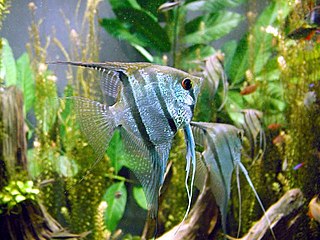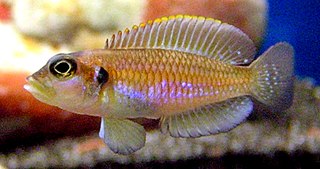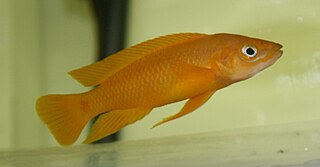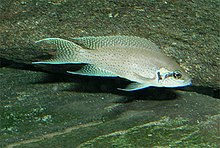
Cichlids are fish from the family Cichlidae in the order Cichliformes. Cichlids were traditionally classed in a suborder, the Labroidei, along with the wrasses (Labridae), in the order Perciformes, but molecular studies have contradicted this grouping. On the basis of fossil evidence, it first appeared in Tanzania during the Eocene epoch, about 46–45 million years ago. The closest living relative of cichlids is probably the convict blenny, and both families are classified in the 5th edition of Fishes of the World as the two families in the Cichliformes, part of the subseries Ovalentaria. This family is both large and diverse. At least 1,650 species have been scientifically described, making it one of the largest vertebrate families. New species are discovered annually, and many species remain undescribed. The actual number of species is therefore unknown, with estimates varying between 2,000 and 3,000.

The terms shell dwellers or shelldwellers, shell-breeding, or ostracophil are descriptive terms for cichlid fish that use the empty shells of aquatic snails as sites for breeding and shelter. The terms have no taxonomic basis, although most shell-dwelling cichlids are from Lake Tanganyikas lamprologine lineage. Many shell dwelling cichlids are popular with fishkeepings and are frequently kept in aquaria.

Julidochromis is a genus of cichlids in the subfamily Pseudocrenilabrinae. They are commonly called julies and are endemic to Lake Tanganyika in eastern Africa. This genus includes six formally described species, some with a number local variants of uncertain taxonomic status. Further taxonomic work is required to determine how many species exist; the closely related Chalinochromis with two more species is sometimes included here and this may be correct. Hybridization makes attempts to determine relationships with molecular phylogenetic methods difficult.

Variabilichromis moorii has no common name and is a species of freshwater cichlid endemic to Lake Tanganyika in eastern Africa. It is a small ovate bodied fish named for an early collector of fish from the lake, John Edmund Sharrock Moore (1870-1947) who was a cytologist, zoologist and led an expedition to Lake Tanganyika and who discovered this species. Juveniles are usually yellow, and adults are dark brown to black in color. It reaches a total length (TL) of 10.3 centimetres (4.1 in). Currently it is the only member of its genus. V. moorii feeds on algae, zooplankton, and benthic invertebrates. It is also found in the aquarium trade.

Neolamprologus is a genus of cichlids endemic to eastern Africa with all but one species, Neolamprologus devosi from the Malagarasi River, occurring in Lake Tanganyika. It is the largest genus of cichlids in Lake Tanganyika and also the largest genus in the tribe Lamprologini, which includes Altolamprologus, Chalinochromis, Julidochromis, Lamprologus, Lepidiolamprologus, Telmatochromis and Variabilichromis. The latter is a monotypic genus doubtfully distinct from Neolamprologus.

Lamprologus ocellatus is a species of shell dwelling cichlid endemic to Lake Tanganyika. It is a popular aquarium fish due to its small size, appearance, and intelligence.

Pelvicachromis pulcher is a freshwater fish of the cichlid family, endemic to Nigeria and Cameroon. It is popular amongst aquarium hobbyists, and is most commonly sold under the name kribensis, although it has other common names, including various derivatives and color morphs of the kribensis: krib, common krib, red krib, super-red krib and rainbow krib, along with rainbow cichlid and purple cichlid.

Neolamprologus multifasciatus is one of the small shell-dwelling cichlids endemic to Lake Tanganyika. The male reaches 5 cm (2 in) in length, and the female only 2.5 cm (1 in) in the aquarium. In the wild, they reach only 3 centimetres (1.2 in) in standard length of male and female reaches less than 2.2 centimetres (0.87 in) in standard length. This makes them one of the smallest cichlid species in the world. Its natural habitat is the Neothauma shell beds of Lake Tanganyika, where it forms huge colonies with thousands of individuals. Their unique behavior is associated with their affinity to shells. They burrow sand to move shells, take refuge in shells and also breed in them. They have pale white coloring with black vertical bars running the length of their bodies. The species is sexually monomorphic, meaning sexing individuals is extremely hard or impossible based on external appearance alone.

Neolamprologus leleupi is a species of cichlid endemic to Lake Tanganyika where it occurs throughout the lake. It is a recess-dweller, inhabiting cracks and crevices. It feeds on invertebrates living in the rich biocover of the substrate. This species reaches a length of 10 centimetres (3.9 in) TL. The color of this fish ranges from bright yellow to deep brown. Both color variations exist at each location where this species is found. This relatively small cichlid is a substrate spawner. It is easily confused with the very similar N. longior a fish also endemic to Lake Tanganyika. The specific name honours the Belgian entomologist Narcisse Leleup (1912-2001), who collected the type.

Chalinochromis brichardi is a species of fish in the family Cichlidae. It is found in Burundi, the Democratic Republic of the Congo, Tanzania, and Zambia. It is endemic to Lake Tanganyika. It builds a nest of rubble which is hidden by plants or algae, and its diet consists primarily of invertebrates. The specific name of this fish honours the fish dealer Pierre Brichard (1921-1990), who was the collector of the type.
Copadichromis geertsi is a species of haplochromine cichlid which is endemic to Lake Malawi.

The convict julie is a cichlid species in the subfamily Pseudocrenilabrinae family endemic to Lake Tanganyika. Hence it is found in Burundi, the Democratic Republic of the Congo, Tanzania, and Zambia. The fish is named after Charles Tate Regan.

Limnotilapia dardennii, the latticed cichlid, is a species of cichlid endemic to Lake Tanganyika, where it prefers rocky areas near the coast. It may also be found in the aquarium trade. This species is currently the only known member of its genus.
Neolamprologus buescheri is a species of cichlid endemic to Lake Tanganyika. This species can reach a length of 8 centimetres (3.1 in) TL. It can also be found in the aquarium trade. The specific name of this cichlid honours the collector of its type, the German ichthyologist Heinz H. Büscher.

Neolamprologus pulcher is a species of cichlid endemic to Lake Tanganyika where it prefers locations with plenty of sedimentation. The common names for N. pulcher include daffodil cichlid, fairy cichlid, princess of Zambia and lyretail cichlid. This species can reach a length of 10 centimetres (3.9 in) TL. It can also be found in the aquarium trade.
Neolamprologus schreyeni is a species of cichlid endemic to Lake Tanganyika where it is only known from along the Burundi coast, inhabiting crevices. This species reaches a length of 5 centimetres (2.0 in) TL. The specific name honours Andre Schreyen, the nephew of and collaborator with the fish trader Pierre Brichard (1921-1990), who was the collector of the type.
Tropheus brichardi is a species of cichlid endemic to Lake Tanganyika where it is found in areas with substrates of solid rock in the central portion of the lake. This species can reach a length of 10 cm (3.9 in). It can be found in the aquarium trade. The specific name honours Pierre Brichard (1921–1990) the aquarium fish exporter who provided the authors with the type.

Lamprologini is a tribe of African cichlid fishes. It contains seven genera and nearly 100 species. Over half of the species in this tribe are in the large genus Neolamprologus. Most genera in the tribe are endemic to Lake Tanganyika, but one species of Neolamprologus is from the Malagarasi River in Tanzania, and several species of Lamprologus are from the Congo River Basin.
Max Fernand Leon Poll was a Belgian ichthyologist who specialised in the Cichlidae. In the years 1946 and 1947 he organised an expedition to Lake Tanganyika.
Telmatochromis brichardi is a species of cichlid from the tribe Lamprologini, part of the subfamily Pseudocrenilabrinae, endemic to Lake Tanganyika. It feeds on algae in rocky habitat. It is a cavity nester which forms temporary pairs for breeding, in which the male defends the territory and the female tends the brood. The specific name honours the aquarium fish dealer Pierre Brichard (1921-1990).














